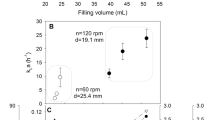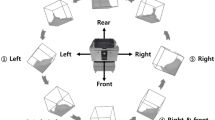Abstract
Heat-shock protein glycoprotein (gp96) serves as a natural adjuvant for chaperoning antigenic peptide into the immune surveillance pathway. In our laboratory, MethA tumor cell suspension culture process has been recently developed for gp96 production in spinner flask. In this work, effects of dissolved oxygen tension (DOT) and agitation rate on this process were studied in stirred-tank bioreactor. The optimal conditions for gp96 production were different with those for MethA tumor cell growth. MethA tumor cell growth pattern was not much changed by various levels of DOT and agitation rate, while gp96 biosynthesis was more sensitive to DOT and agitation rate. Compared with 50% of DOT, the production and specific productivity of gp96 was increased by 27 and 66% at 10% of DOT, respectively. Compared with the agitation rate of 100 rpm, the production and volumetric productivity of gp96 was increased by 48 and 144% at the agitation rate of 200 rpm, respectively. Low DOT (i.e., 10% of air saturation) and high agitation rate (i.e., 200 rpm) were identified to be favorable for gp96 biosynthesis. The results of this work might be useful to scale-up the bioprocess into the pilot scale.








Similar content being viewed by others
References
Hartl FU (1996) Molecular chaperones in cellular protein folding. Nature 381:571–579
Nicchitta CV (1998) Biochemical, cell biological and immunological issues surrounding the endoplasmic reticulum chaperone GRP94/gp96. Curr Opin Immunol 10:103–109
Yang Y, Liu B, Dai J, Srivastava PK, Zammit DJ, Lefrançois L, Li Z (2007) Heat shock protein gp96 is a master chaperone for Toll-like receptors and is important in the innate function of macrophages. Immunity 26(2):215–226
Srivastava PK (2002) Interaction of heat shock proteins with peptides and antigen presenting cells: chaperoning of the innate and adaptive immune responses. Annu Rev Immunol 20:395–425
Srivastava PK (2002) Roles of heat shock proteins in innate and adaptive immunity. Nat Rev Immunol 2:185–194
Baker-LePain JC, Sarzotti M, Nicchitta CV (2004) Glucose-regulated protein 94/glycolprotein 96 elicits bystander activation of CD4+ T cell Th1 cytokine production in vivo. J Immunol 172:4195–4203
Maki RG, Old LJ, Srivastava PK (1990) Human homologue of murine tumor rejection antigen gp96: 5′-regulatory and coding regions and relationship to stress-induced proteins. Proc Natl Acad Sci USA 87:5658–5662
Udono H, Srivastava PK (1994) Comparison of tumor-specific immunogenicities of stress-induced proteins gp96, hsp90 and hsp70. J Immunol 152:5398–5403
Srivastava PK (1997) Purification of heat shock protein-peptide complexes for sue in vaccination against cancers and intracellular pathogens. Method 12:165–171
Chandawarkar RY, Wagh MS, Srivastava PK (1999) The dual nature of specific immunological activity of tumor-derived gp96 preparations. J Exp Med 189:1437–1442
Meng SD, Song J, Rao Z, Tien P, Gao GF (2002) Three-step purification of gp96 from human liver tumor tissues suitable for isolation of gp96-bound peptides. J Immunol Methods 264:29–35
Fairburna B, Muthanaa M, Hopkinsona K, Slacka LK, Mirzaa S, Georgioub AS, Espigaresc E, Wongb C, Pockleya AG (2006) Analysis of purified gp96 preparations from rat and mouse livers using 2-D gel electrophoresis and tandem mass spectrometry. Biochimie 88:1165–1174
Udono H, Levey DL, Srivastava PK (1994) Cellular requirements for tumor-specific immunity elicited by heat shock proteins: tumor rejection antigen gp96 primes CD8+ T cells in vivo. Proc Natl Acad Sci USA 91:3077–3081
Tamura Y, Peng P, Liu K, Daou M, Srivastava PK (1997) Immunotherapy of tumors with autologous tumor-derived heat shock protein preparations. Science 278:117–120
Janetzki S, Palla D, Rosenhauer V, Lochs H, Lewis JJ, Srivastava PK (2000) Immunization of cancer patients with autologous cancer-derived heat shock protein gp96 preparations: a pilot study. Int J Cancer 88:232–238
Srivastava PK, Jaikaria NS (2001) Methods of purifications of heat shock protein-peptide complexes for use as vaccines against cancers and infectious diseases. Methods Mol Biol 156:175–186
Tang YJ, Li HM, Hamel JFP (2007) Suspension culture process of MethA tumor cell for the production of heat-shock protein glycoprotein 96: process optimization in spinner flasks. Biotechnol Prog 23(6):1363–1377
Rose S, Black T, Ramarkrishnan D (2003) Mammalian cell culture: process development considerations. In: Vinci VA, Parekh SR (eds) Handbook of industrial cell culture: mammalian, microbial, and plant cells. Humana Press, Totowa, pp 69–103
Miller WM, Blanch HW, Wilke CR (1988) A kinetic analysis of hybridoma cell growth and metabolism in batch and continuous culture: effect of nutrient concentration, dilution rate, and pH. Biotechnol Bioeng 32:947–965
Ozturk SS, Palsson BO (1991) Growth, metabolic, and antibody production kinetics of hybridoma cell culture: 2. Effects of serum concentration, dissolved oxygen concentration, and medium pH in a batch reactor. Biotechnol Prog 7:481–494
Tang YJ, Ohashi R, Hamel JFP (2007) Perfusion culture of hybridoma cell for hyperproduction of IgG2a monoclonal antibody in a wave bioreactor-perfusion culture system. Biotechnol Prog 23:255–264
Dong H, Tang YJ, Ohashi R, Hamel JFP (2005) A perfusion culture system using a stirred ceramic membrane reactor for hyperproduction of IgG2a monoclonal antibody by hybridoma cells. Biotechnol Prog 21:140–147
Ohashi R, Otero JM, Chwistek A, Yamato I, Hamel JFP (2002) On-line purification of monoclonal antibodies using an integrated stirred-tank reactor/expanded-bed adsorption system. Biotechnol Prog 18:1292–1300
Ohashi R, Otero JM, Chwistek A, Hamel JFP (2002) Determination of monoclonal antibody production in cell culture using novel microfluidic and traditional assays. Electrophoresis 23:3623–3629
Konz JO, King J, Cooney CL (1998) Effects of oxygen on recombinant protein expression. Biotechnol Prog 14:393–409
Burdon RH (1994) Oxidative stress in cultured animal cells. In: Spier RE, Griffiths JB (eds) Animal cell biotechnology, Vol. 6. London, UK: Academic Press. Academic Press, Orlando, pp 129–160
Imlay JA, Linn S (1988) DNA damage and oxygen radical toxicity. Science 240:1302–1309
Ozturk SS, Palsson BO (1990) Effects of dissolved oxygen on hybridoma cell growth, metabolism, and antibody production kinetics in continuous culture. Biotechnol Prog 6:437–446
Restelli V, Wang MD, Huzel N, Ethier M, Perreault H, Butler M (2006) The effect of dissolved oxygen on the production and the glycosylation profile of recombinant human erythropoietin produced from CHO cells. Biotechnol Bioeng 94:481–494
Miller WM, Wilke CR, Blanch HW (1987) Effects of dissolved oxygen concentration on hybridoma growth and metabolism in continuous culture. J Cell Physiol 132:524–530
Ogawa T, Kamihira M, Yoshida H, Iijima S, Kobayashi T (1992) Effect of dissolved oxygen concentration on monoclonal antibody production in hybridoma cell cultures. J Ferm Bioeng 74:372–378
Phillips HA, Scharer JM, Bols NC, Moo-Young M (1987) Effect of oxygen on antibody productivity in hybridoma culture. Biotechnol Letts 9:745–750
Oberley TD, Schultz JL, Li N, Oberley LW (1995) Antioxidant enzyme levels as a function of growth state in cell culture. Free Radic Biol Med 19:53–65
Lin AA, Miller WM (1992) CHO cell responses to low oxygen: regulation of oxygen consumption and sensitisation to oxidative stress. Biotechnol Bioeng 40:505–516
Zhang Z, Chisti Y, Moo-Young M (1995) Effects of the hydrodynamic environment and shear protectants on survival of erythrocytes in suspension. J Biotechnol 43:33–40
Kunas KT, Papoutsakis ET (1990) Damage mechanisms of suspended animal cells in agitated bioreactors with and without bubble entrainment. Biotechnol Bioeng 36:476–483
Petersen JF, McIntire LV, Papoutsakis ET (1990) Shear sensitivity of hybridoma cells in batch, fed-batch, and continuous cultures. Biotechnol Prog 6:14–120
Lakhotia S, Bauer KD, Papoutsakis ET (1992) Damaging agitation intensities increase DNA synthesis rate and alter cell-cycle phase distributions of CHO cells. Biotechnol Bioeng 40(8):978–990
Keane JT, Ryan D, Gray PP (2003) Effect of shear stress on expression of a recombinant protein by Chinese hamster ovary cells. Biotechnol Bioeng 81:211–220
Pechan PM (1991) Heat shock proteins and cell proliferation. FEBS Lett 280:1–4
Acknowledgment
The financial supports from the National Natural Science Foundation of China (NSFC, Project No. 20706012), National High Technology Research and Development Key Program of China (Project No. 2007AA021506), the Scientific Research Foundation for the Returned Overseas Chinese Scholars (Ministry of Personnel and State Education Ministry), Hubei Provincial Innovative Research Team in University (Project No. T200608), Hubei Provincial Science Foundation for Distinguished Young Scholars (Project No. 2006ABB034), Hubei Provincial International Cooperation Foundation for Scientific Research (Project No.2007CA012), the Science and Technology Commission of Wuhan Municipality “Chenguang Jihua” (Project No. 20065004116-31), the Scientific Research Key Foundation from Hubei University of Technology (Project No. 306.18002), and the Open Project Program of the State Key Laboratory of Bioreactor Engineering (ECUST) are gratefully acknowledged. The authors thank Nova Biomedical Corp. (MA, USA) for the loan of the BioProfile 200 Analysator, and Innovatis GmbH (Germany) for the loan of the Cedex® system. Ya-Jie Tang also thanks the Chutian Scholar Program from Hubei Provincial Department of Education, China (2006).
Author information
Authors and Affiliations
Corresponding author
Rights and permissions
About this article
Cite this article
Tang, YJ., Li, HM. & Hamel, JF.P. Effects of dissolved oxygen tension and agitation rate on the production of heat-shock protein glycoprotein 96 by MethA tumor cell suspension culture in stirred-tank bioreactors. Bioprocess Biosyst Eng 32, 475–484 (2009). https://doi.org/10.1007/s00449-008-0267-8
Received:
Accepted:
Published:
Issue Date:
DOI: https://doi.org/10.1007/s00449-008-0267-8




